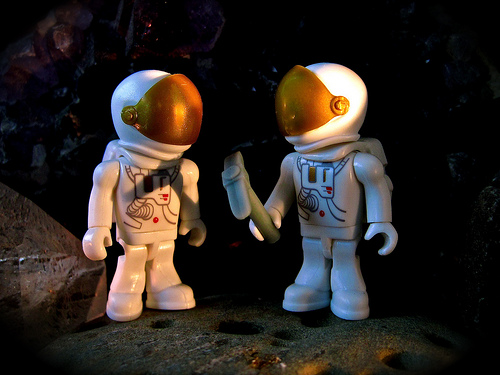Top Ten Largest Asteroid Impacts in History
Of all naturally occurring phenomenon, asteroid impacts are one of the most destructive of all. The impact of an asteroid releases as much energy as hundreds, if not thousands, of atomic bombs. It is believed that a series of asteroid impacts was enough to cause the mass extinction of the dinosaurs roughly 65 million years ago.
10
Chesapeake Bay Crater
Virginia, United States
Impact date: 35 million years ago
The Chesapeake Bay Crater is the largest known crater located within the United States. It is also one of the most well-preserved known craters located underwater. The asteroid that hit essentially created the Chesapeake Bay. The diameter is roughly 85 km across. The discovery of the crater was confirmed in 1993 as a result of oil exploration.
9
Popigai Crater
Siberia, Russia
Impact date: 35.7 million years ago
The Popigai Crater could be one of the most highly valued craters in the world. Late last year, Russia stated there are massive diamond reserves under the crater containing over a trillion carets, which based on current diamond demand would supply the world for over 3,000 years. The crater itself measures almost 100 km across. Based on the standard margin of error it could have occurred at the same time the Chesapeake Bay Crater was formed. The asteroid behind this crater was estimated to have been about 8 km across.
8
Chicxulub Crater
Yucatán, Mexico
Impact date: 65 million years ago
The Chicxulub Crater is famous because many scientists believe the asteroid that caused this crater could have possibly been the asteroid, or one of the asteroids, that caused the extinction of the dinosaurs. The time frame of 65 million years ago strongly coincides when the last known dinosaurs walked the Earth. The crater itself is more than 180 km due to the soft rock found in the area, making it the largest impact structure on the planet, although the asteroid that caused it is only estimated having been upward of 10 km in diameter at most. The impact was discovered in the late 1970’s by a team of geophysisits working for a Mexican state-owned oil company.
7
Kara Crater
Nenetsia, Russia
Impact date: 70.3 million years ago
The Kara Crater is roughly 65 km in diameter, but some scientists believe it may have been up to 120 km in size, which would actually make it the 4th largest verified impact crater if true. The crater is located right on the coast of the Baydarata Gulf and is not exposed to the surface.
6
Morokweng Crater
North West, South Africa
Impact date: 145 million years ago
Scientists believe the asteroid that caused the Morokweng Crater was between 5 to 10 km in diameter. The crater that formed from the impact is about 70 km across. Located beneath the Kalahari Desert near the town of Morokweng, it was first discovered in 1994. Fragments from this impact are available to be seen by the public at the London Science Museum.
5
Manicougan Crater
Quebec, Canada
Impact date: 215 million years ago
The Manicougan Crater is one of the most easily observed craters in the world. The crater itself forms a concentric ring structure about 100 km across with its 70 km inner ring being the most prominent feature of the crater. The inner ring forms an annular lake that has filled in the impact site.
4
Woodleigh Crater
Western Australia, Australia
Impact date: 364 million years ago
The Woodleigh Crater was not discovered until April of 2000 when it was announced in an issue of Earth and Planetary Science Letters. The surface of the crater is no longer exposed, making its exact size subject to uncertainty. The team who discovered the crater estimates it is roughly 120 km in diameter, but many others argue it is quite a bit smaller, with most estimates coming in at around 37 km to 90 km.
3
Acraman Crater
South Australia, Australia
Impact date: 580 million years ago
The Acraman crater is located in the Gawler Ranges of South Australia. Since its impact a large lake, Lake Acraman has formed in its place. The original diameter of the crater was estimated to be about 90 km across, but due to the massive amount of erosion over time in the area, the lake and crater are only about 20 km across today. Due to being covered by a lake, the exact age of the impact is one of the harder ones to verify. Nearby sedimentary basins provide a clue leading experts to believe the impact took place about half a billion years ago.
2
Sudbury Basin
Ontario, Canada
Impact date: 1.8 billion years ago
The Subury Basis is located on the Canadian Shield. It is the location of the largest verified impact crater in North America. The asteroid that created this crater was estimated to be between 9-14 km in diameter. Upon impact, the debris scattered over an estimated 1,600,000 square km area and traveled upwards of 800 km away. Rock fragments linked to this impact have been found as far away as Minnesota.
1
Vredefort Crater
Free State, South Africa
Impact date: 2 billion years ago
This crater located in South Africa named after the town of Vredefort is the largest verified impact crater on earth. It measures more than 300 km across.The asteroid that created this crater is likely to have been one of the largest to have ever struck Earth. It is estimated to have been 5-10 km in diameter. It is also the second-oldest crater currently known of the planet. Ironically, it wasn’t determined until the 1990’s that the crater was a result of an asteroid impact. It was originally believed to be a result of a massive volcanic explosion.
Featured Image: Flickr by puuikibeach
